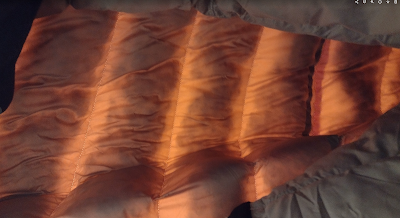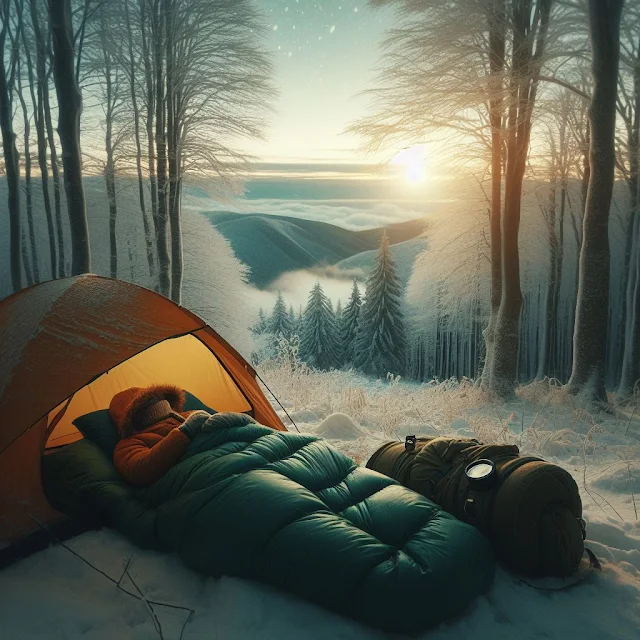My quest to find a comfortable sleep system for restless side sleepers who want to go camping in the cold continues. How's that for a hyper-specific target audience? I am publishing this post for the dozens (probably?) of others out there like me who are not served by the mass-market reviews of gear because we have unique needs that our sleeping bags must meet that are usually overlooked. We flop around like a fish out of water. We spread our arms like outriggers on a Polynesian canoe. We spread our legs like, um, never mind, that one. My point is, bags that are critically acclaimed in reviews and ratings, don't work for me.
Quilts have been my salvation for most trips. See my review of the Enlightened Equipment Revelation and Zenbivy Light Bed for details. However, the comfort of these solutions starts to become problematic as the mercury drops below freezing. My latest attempt to solve this problem is to get an inexpensive, lightweight rectangular sleeping bag to use inside my quilt on sub-freezing nights.
After an extensive online search comparing options, I purchased a ForestDawn down sleeping bag rated for 40-60F. It was $59.99 with a 15% coupon, so total came to $51 which is a pretty good deal for a down bag. That's less than the price of brand-name fleece liners that are purported to only add 5 to 10 degrees of temperature capability to your bag. I'm hopeful this will do a whole lot better.
Aside from the price, my reasons for choosing this bag were:
- Rectangular design- lots of room
- Weight- 2.6lbs Not exactly hyperlight, but not too bad for the price
- Packed Size- again, not super small, but decent for the price.
This bag, combined with my Revelation quilt come to about 4.2lbs This is on par with many Winter bags that claim to be comfortable down to 0F. The size of the two bags is a little bulky, but not out of line compared to other single, large, Winter bags. If this combo can keep me toasty when the temps are in the single digits, then I say it is well worth the size and weight.
 |
| My Cold Weather Sleep System Ready for Packing |
The picture above shows what my total cold weather sleep system looks like ready to be stuffed into a backpack. The orange stuff sack is the 40 degree ForestDawn sleeping bag. The Blue stuff sack is the 0 degree Revelation Quilt. The blue bag is the Neoair XLite pad. The two small stuff sacks are the down hood and the inflatable pillow. The Nalgene bottle is shown for size reference, though it is, in fact, part of the sleep system. Fill it with nearly boiling water, stuff it in a sock and bring it to bed with you for a hot water bottle that will help keep you warm all night and extend the temperature range in which you will be comfortable.
My first impressions of the bag were a mix of good and bad. The material felt good, like a traditional sleeping bag, not the mouse fur stuff of the last inexpensive bag I tried, the
Omnicore -10F mummy. The package it arrived in was nice and small (good). It also came in a nice compression stack (good). The down was pretty heavily compressed, so I gave it some time to fluff up, but it never really fluffed as much as I was expecting (bad).

Maybe that is the difference between the 500 fill power down used in this bag and the 800 fill power down used in the Revelation quilt. The main thing I noticed is the stitching of the bag is in horizontal lines designed to keep the down from getting too far out of place, but they used through-stitching that results in there being no insulation along each stitch line (bad). You can see that when holding the bag up to the light. I guess that is to be expected in an inexpensive, lightweight summer bag. I hoped it didn't mean it would let cold through when I stuffed it inside my quilt.
 |
| Backlighting shows the down distribution and lack of insulation along the stitches |
I only had to wait a few days for a night cold enough to give my bag and quilt combo a test: 28F. It isn't really as cold as I wanted, but cold enough to give me some idea if this is going to work at all. I attached the Revelation quilt to the pad with its straps and loosened them some to create a little extra room. I then stuffed the new bag inside. The head and neck area presented a little problem. The Revelation has no hood and a couple of snaps and a drawtring that cinches the quilt up around your neck. The Forestdawn bag has a hood area with a cinch and a collar that can be cinched up around your neck. I chose to button and cinch the quilt around my neck and have the bag collar inside of that. I put my Trekology pillow in the bag hood area which took up most of the hood area.
 |
| Bag inside the quilt with the quilt collar providing the main seal |
With a little work, I could tighten up the quilt around my neck and get a seal sufficient to keep cold drafts out for the most part. It did still let a small amount of cold air in when I would roll around, so next time I might try the opposite and keep the quilt collar on the outside and cinch up the bag around my neck instead to see how it does. The image below shows this arrangement.
 |
| Bag inside the quilt with the bag collar providing the main seal |
I was plenty warm initially. So warm, in fact, that I only used a thin acrylic hat to sleep in. That proved to be the biggest problem for my sleep that night. The bag + quilt had plenty of room in it for me to splay out and I was able to roll over from one side to the other without much trouble. There were no cold spots coming through and the the drafts that I used to feel when I rolled over with just the quilt were gone. I did wake up sometime in the early morning hours and was a little cold, but this seemed to be mostly my head. I swapped out my hat for a down hood and went back to sleep and had no further problems with being cold. The built in hood in the bag wasn't big enough to cinch up around my head when my inflatable pillow was in it, but that is OK. I typically can't use the built-in hoods in sleeping bags because they don't roll with me when I roll over and I end up breathing into the bag and creating bad moisture inside the bag. My standalone down hood rolls with me and keeps the breathing opening aligned with my mouth and nose, so I prefer using it anyway, so the small hood on this bag isn't a problem for me.
In summary, I am satisfied with this arrangement so far. I still want to test it in lower temperatures to find out what the comfort limit of this combo really is. The size and weight are acceptable for occasional use in extreme cold, and I can also use the inner bag in the summer if I choose, though it is still heavier than the quilt. The only reason for using this bag over the quilt would be to save the wear and tear on the more expensive quilt.










Comments
Post a Comment